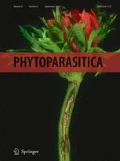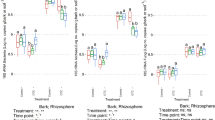Abstract
Small spots are a newly-defined manifestation ofBotrytis cinerea infection on phylloclades of ruscus. The dark, water-soaked spots encircled by a faint halo, which are found on young phylloclades, become brown lesions later but do not grow in size. Control of all symptoms caused byB. cinerea on ruscus (Ruscus hypoglossum L.),i.e., phylloclade rot or restricted lesions, upper branch rot, and stem canker, was achieved by sprays of fenetrazole (alone), diethofencarb + carbendazim, vinclozolin (alone) or alternately by sprays of diethofencarb + carbendazim, polyoxin B, and polyoxin D. Delay of disease development was achieved by copper sulfate pentahydrate and by the spray adjuvant Nufilm at a high rate of application. Mixing vinclozolin with copper, fenetrazole, TMTD or Nufilm did not control disease better than vinclozolin or fenetrazole alone. Postharvest control of gray mold (up to 72% reduction) in mature branches stored at 18°C was achieved by some of the above mentioned fungicides and by dichloftuanid, tebuconazole (alone or mixed together), iprodione, polyoxin AL, and vinclozolin + TMTD. Measures designed to improve field control of Botrytis epidemics in ruscus are discussed.
Similar content being viewed by others
References
Elad, Y. (1988) Latent infection ofBotrytis cinerea in rose flowers and combined chemical and physiological control of the disease.Crop Prot. 7:361–366.
Elad, Y. (1989) Effect of abiotic conditions on development of grey mould of rose and scanning electron microscopy.Phytopathol. Medit. 28:122–130.
Elad, Y., Ayish, N., Ziv, O. and Katan, J. (1990) Control of grey mould with film-forming polymers.Plant Pathol. 39:249–254.
Elad, Y., Yunis, H. and Katan, T. (1992) Multiple resistance to benzimidazoles, dicarboximides and diethofencarb in field isolates ofBotrytis cinerea in Israel.Plant Pathol. 41:41–46.
Elad, Y., Yunis, H., Volpin, H. and Pressman, E. (1991) Fertilization of plants grown in soil-less media by calcium for the reduction of foliar diseases.Phytoparasitica 19:168 (abstr.).
Elad, Y., Ziv, O., Ayish, N. and Katan, J. (1989) Effect of film-forming polymers on powdery mildew of cucumber.Phytoparasitica 17:279–288.
Kritzman, G. and Netzer, D. (1978) A selective medium for isolation and identification ofBotrytis spp. from soil and onion seeds.Phytoparasitica 6:3–7.
Salinas, J., Glandorf, D.C.M., Picavet, E.D. and Verhoeff, K. (1989) Effect of temperatures, relative humidity and age of conidia on the incidence of spotting on gerbera flowers caused byBotrytis cinerea.Neth. J. Plant Pathol. 95:51–64.
Verhoeff, K. (1970) Spotting of tomato fruits caused byBotrytis cinerea.Neth. J. Plant Pathol. 76:219–226.
Volpin, H. and Elad, Y. (1991) Influence of calcium nutrition on susceptibility of rose flowers to Botrytis blight.Phytopathology 81:1390–1394.
Yunis, H., Elad, Y. and Mahrer, Y. (1990) Influence of fungicide control of cucumber and tomato grey mould (Botrytis cinerea) on fruit yield.Pestic. Sci. 31:325–335.
Author information
Authors and Affiliations
Rights and permissions
About this article
Cite this article
Elad, Y., Kirshner, B., Gokkes, M. et al. Disease symptoms caused byBotrytis cinerea inRuscus hypoglossum plants and their control. Phytoparasitica 21, 53–61 (1993). https://doi.org/10.1007/BF02980871
Received:
Issue Date:
DOI: https://doi.org/10.1007/BF02980871




